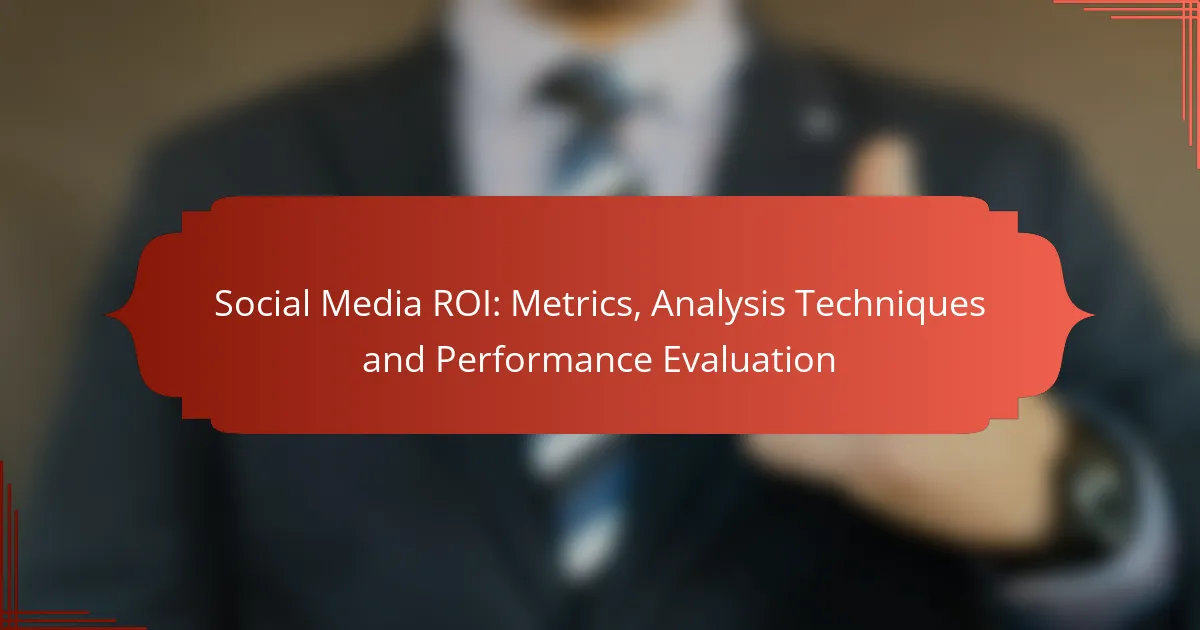Understanding Social Media ROI is essential for businesses looking to maximize their investments in digital marketing. By measuring the financial returns against the costs, companies can align their social media strategies with overall business goals. Utilizing various analysis techniques allows for deeper insights into performance and audience engagement, ultimately guiding optimization efforts.
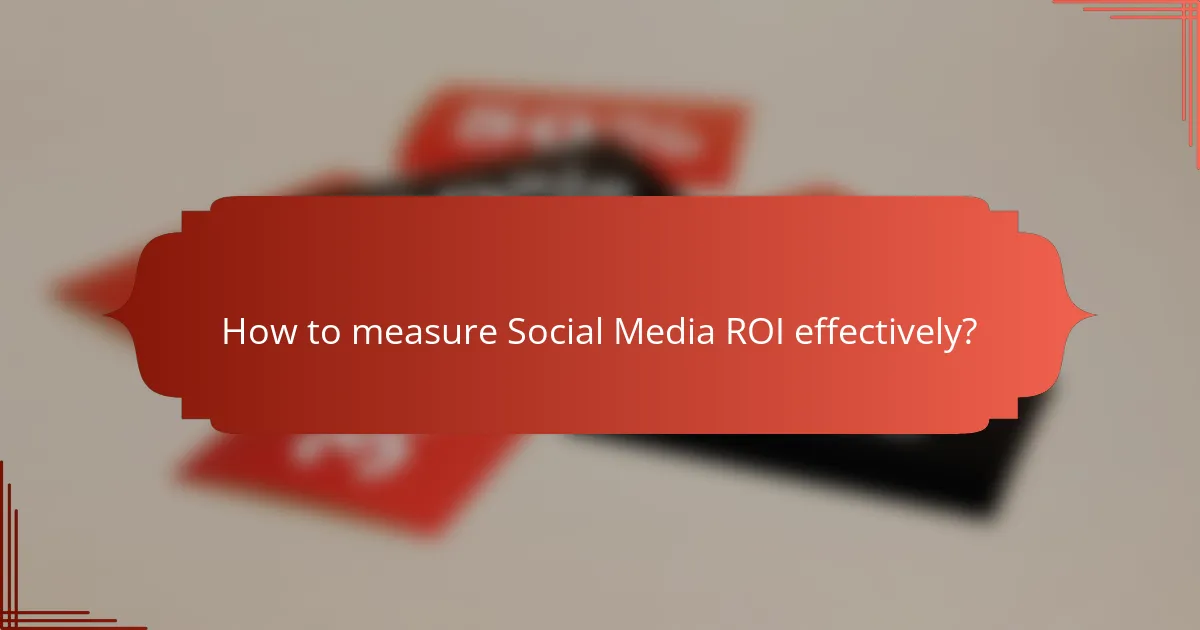
How to measure Social Media ROI effectively?
Measuring Social Media ROI effectively involves assessing the financial return generated from social media investments against the costs incurred. This process requires a clear understanding of key metrics and how they relate to overall business objectives.
Key performance indicators (KPIs)
Key performance indicators (KPIs) are essential metrics that help evaluate the success of social media efforts. Common KPIs include reach, impressions, engagement rates, and follower growth. Selecting the right KPIs aligns your social media strategy with business goals, ensuring that you track what truly matters.
To determine which KPIs to focus on, consider your specific objectives, such as brand awareness or lead generation. Regularly reviewing these indicators allows for timely adjustments to your strategy.
Cost per acquisition (CPA)
Cost per acquisition (CPA) measures the total cost associated with acquiring a new customer through social media channels. This metric is calculated by dividing total marketing costs by the number of new customers acquired. Understanding CPA helps businesses evaluate the efficiency of their social media campaigns.
Aiming for a lower CPA is generally favorable, but it’s crucial to balance cost with quality. For instance, a higher CPA might be acceptable if it leads to higher-value customers or increased lifetime value.
Customer lifetime value (CLV)
Customer lifetime value (CLV) estimates the total revenue a business can expect from a single customer throughout their relationship. This metric is vital for understanding the long-term impact of social media investments. A higher CLV indicates that your social media strategy is effectively attracting and retaining valuable customers.
To maximize CLV, focus on engaging customers through personalized content and excellent customer service. Regularly analyzing CLV can inform your marketing budget and help identify profitable customer segments.
Engagement metrics
Engagement metrics, such as likes, shares, comments, and click-through rates, gauge how audiences interact with your content. High engagement levels often correlate with increased brand loyalty and awareness. Tracking these metrics can provide insights into what resonates with your audience.
To enhance engagement, create compelling content that encourages interaction. Experiment with different formats, such as videos or polls, to see what drives the most engagement from your followers.
Conversion rates
Conversion rates measure the percentage of users who take a desired action, such as making a purchase or signing up for a newsletter, after interacting with your social media content. This metric is crucial for assessing the effectiveness of your social media campaigns in driving tangible results.
To improve conversion rates, ensure that your calls-to-action are clear and compelling. A/B testing different approaches can help identify the most effective strategies for converting social media traffic into customers.

What analysis techniques enhance Social Media ROI?
To enhance Social Media ROI, various analysis techniques can be employed, each providing unique insights into performance and audience engagement. These techniques help businesses understand their impact on social media and optimize their strategies accordingly.
Sentiment analysis tools
Sentiment analysis tools evaluate the emotions behind social media mentions, helping brands gauge public perception. By analyzing comments, posts, and reviews, these tools categorize sentiments as positive, negative, or neutral, providing a clearer picture of audience attitudes.
Popular sentiment analysis tools include Brandwatch and Hootsuite Insights. They can help identify trends in customer feelings over time, allowing businesses to adjust their messaging and improve engagement strategies based on audience feedback.
Attribution modeling
Attribution modeling assigns credit to various touchpoints in the customer journey, helping businesses understand which social media efforts drive conversions. This technique can clarify how different platforms contribute to overall ROI, guiding budget allocation and strategy adjustments.
Common models include first-click, last-click, and multi-touch attribution. Each has its advantages and trade-offs, so selecting the right model depends on the specific goals and customer behavior patterns of the business.
Social listening platforms
Social listening platforms monitor online conversations about a brand, product, or industry, providing insights into customer needs and market trends. These tools help businesses stay informed about what their audience is discussing and how they perceive their brand.
Tools like Sprout Social and Mention can track keywords and hashtags, allowing brands to respond proactively to customer inquiries or concerns. This engagement can enhance brand loyalty and improve overall ROI by fostering a positive community around the brand.
Benchmarking against competitors
Benchmarking against competitors involves comparing social media performance metrics with those of similar brands. This technique helps identify strengths and weaknesses in a brand’s social media strategy, offering insights into potential areas for improvement.
Key metrics to compare include engagement rates, follower growth, and content performance. Tools like Rival IQ and SEMrush can facilitate this analysis, enabling brands to set realistic goals and adjust their strategies based on industry standards and competitor performance.
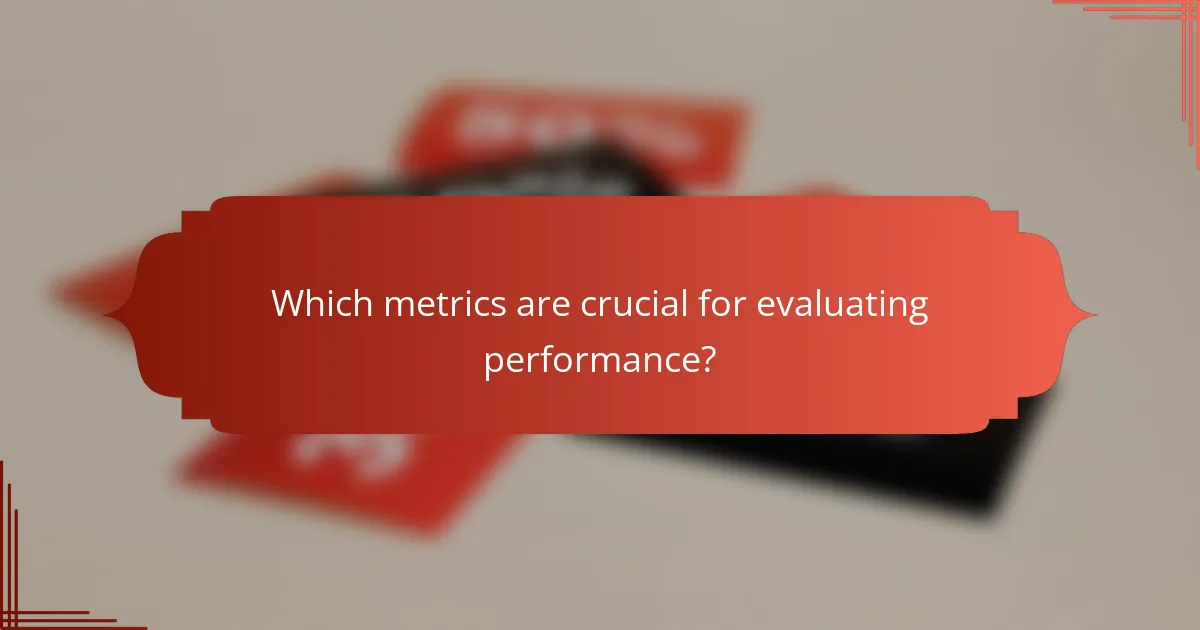
Which metrics are crucial for evaluating performance?
Evaluating performance on social media requires focusing on key metrics that reflect the effectiveness of your campaigns. Crucial metrics include return on ad spend (ROAS), engagement rate, traffic generated from social media, and lead generation statistics.
Return on ad spend (ROAS)
Return on ad spend (ROAS) measures the revenue generated for every dollar spent on advertising. A higher ROAS indicates a more effective ad campaign, typically aiming for a ratio of at least 4:1, meaning four dollars earned for every dollar spent.
To calculate ROAS, divide the total revenue from ads by the total ad spend. For example, if you earned $10,000 from a $2,000 ad investment, your ROAS would be 5:1. Monitoring this metric helps in optimizing ad budgets and strategies.
Engagement rate
Engagement rate reflects how effectively your audience interacts with your content, including likes, shares, comments, and clicks. A higher engagement rate signifies that your content resonates well with your audience, which is crucial for brand loyalty.
To calculate engagement rate, divide the total engagements by the total followers or impressions, then multiply by 100 to get a percentage. Aim for engagement rates above 1-3% for most platforms, as this indicates healthy audience interaction.
Traffic generated from social media
Traffic generated from social media measures the number of visitors directed to your website through social media channels. This metric is vital for assessing the effectiveness of social media in driving potential customers to your site.
Use tools like Google Analytics to track social media traffic. Look for trends over time and compare traffic sources to identify which platforms are most effective. Aiming for a steady increase in social media traffic can indicate successful content and engagement strategies.
Lead generation statistics
Lead generation statistics track the number of potential customers acquired through social media efforts. This metric is essential for understanding how well your campaigns convert engagement into actionable leads.
To evaluate lead generation, monitor the number of sign-ups, inquiries, or downloads resulting from social media campaigns. A good benchmark is to aim for a conversion rate of 2-5% from social media traffic, depending on your industry and target audience.
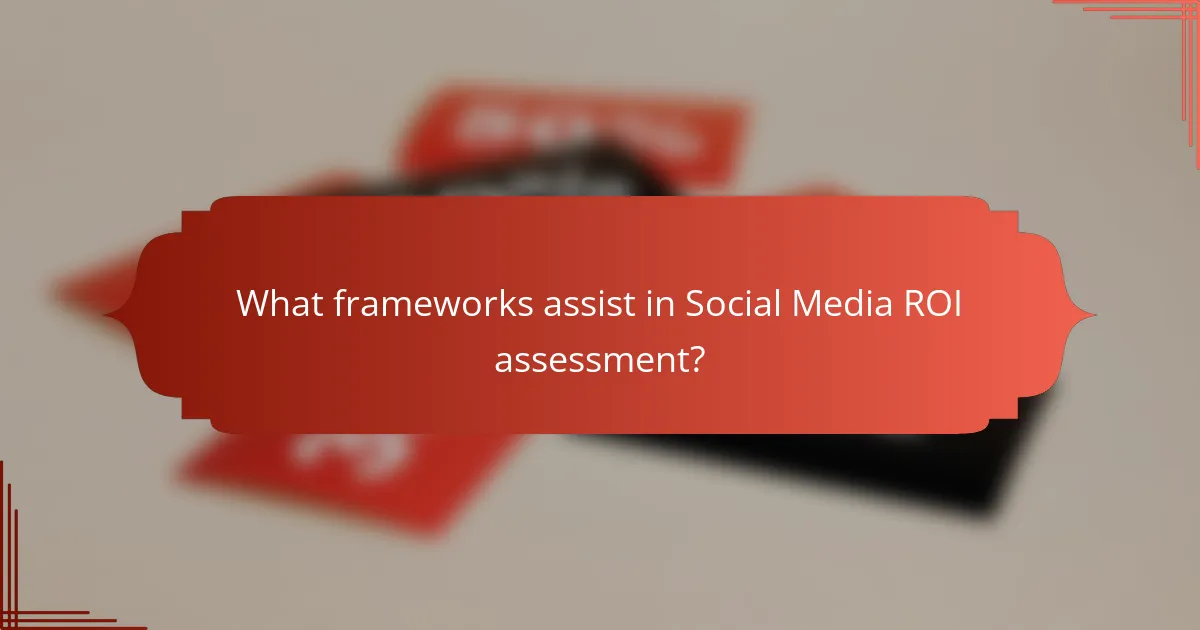
What frameworks assist in Social Media ROI assessment?
Several frameworks can effectively assist in assessing Social Media ROI by providing structured approaches to measure performance and outcomes. Utilizing these frameworks helps organizations align their social media efforts with business objectives and evaluate their effectiveness.
SMART goals framework
The SMART goals framework is a widely used method for setting specific, measurable, achievable, relevant, and time-bound objectives. This approach ensures that social media goals are clear and focused, making it easier to track progress and evaluate success.
For example, instead of setting a vague goal like “increase engagement,” a SMART goal would be “increase Instagram engagement by 20% over the next three months.” This specificity allows for more effective measurement and analysis of ROI.
When applying the SMART framework, avoid setting overly ambitious goals that may lead to frustration. Instead, aim for realistic targets that can be adjusted based on performance data.
Balanced scorecard approach
The balanced scorecard approach offers a comprehensive view of organizational performance by evaluating multiple perspectives, including financial, customer, internal processes, and learning and growth. This method helps in assessing social media ROI by linking social media activities to broader business objectives.
For instance, a company might measure social media success not just by engagement metrics but also by how these efforts contribute to customer satisfaction and retention rates. This holistic view can provide deeper insights into the effectiveness of social media strategies.
When implementing the balanced scorecard, ensure that each perspective is aligned with specific metrics. Regularly review these metrics to adapt strategies as needed, ensuring continuous improvement in social media performance and ROI evaluation.
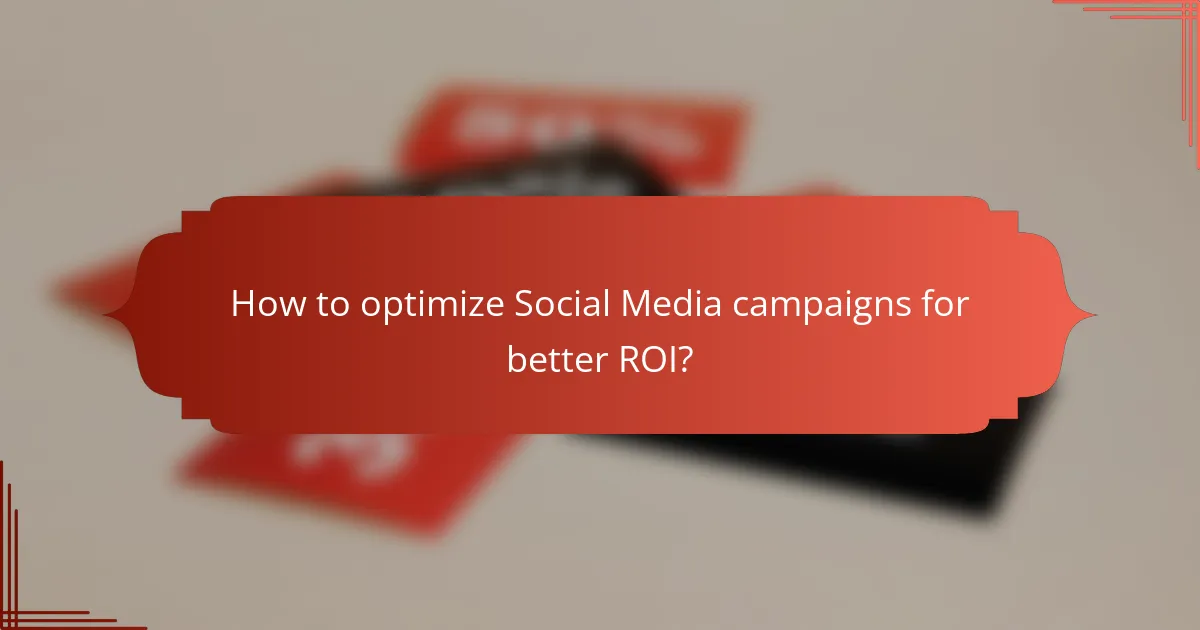
How to optimize Social Media campaigns for better ROI?
To optimize social media campaigns for better ROI, focus on data-driven strategies that enhance engagement and conversion rates. Implementing effective testing, content strategies, and audience segmentation can significantly improve your campaign performance.
A/B testing strategies
A/B testing involves comparing two versions of a campaign to determine which performs better. This can include variations in ad copy, images, or call-to-action buttons. By analyzing metrics such as click-through rates and conversion rates, you can identify the most effective elements.
Start with small changes to minimize risk, such as altering headlines or images. Aim for a sample size that provides statistically significant results, typically in the low hundreds to low thousands, depending on your audience size.
Content optimization techniques
Content optimization focuses on enhancing the quality and relevance of your posts to increase engagement. Use high-quality visuals, compelling headlines, and clear calls to action to draw in your audience. Regularly analyze which types of content (videos, infographics, articles) resonate most with your followers.
Consider using tools that analyze engagement metrics to refine your content strategy. Aim for a consistent posting schedule, ideally several times a week, to keep your audience engaged and informed.
Target audience segmentation
Target audience segmentation involves dividing your audience into smaller groups based on demographics, interests, or behaviors. This allows for tailored messaging that speaks directly to each segment’s needs, increasing the likelihood of engagement and conversion.
Utilize social media analytics tools to gather insights on your audience’s preferences. Create targeted ads for different segments, adjusting your budget allocation based on performance metrics. This approach can lead to higher ROI by ensuring your messaging is relevant and impactful.
